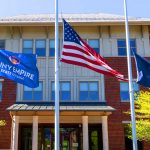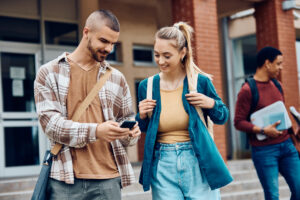As community colleges emerge from the COVID pandemic new challenges around enrollment and retention are emerging. Community college leaders are now tasked with overcoming these challenges and guiding their institutions toward financial stability.
Ocelot recently sat down with Dr. James Catanzaro, a community college president for nearly four decades, to hear his perspectives on how community colleges can navigate the current challenges.
****
Ocelot: In our last interview, you spoke about the importance of teamwork, especially when it comes to online and hybrid courses. Can you tell us a bit more about why that is so critical?
Dr. Catanzaro: I repeat a point stressed in a previous Ocelot interview: I believe we need to look at incorporating teamwork into most all of our courses to gain the outcomes we seek. It’s teamwork that is increasingly valued in the workplace, and it is teamwork that can greatly enrich college courses. Once again, technology can easily make this a reality – in class, online, through blended modalities.
I like breaking my classes into teams of five or so, especially classes of 35, 40, 45. This requires all students to work purposely together toward their individual and collective success. In this scheme, every week the leader of the team changes, so that over the term every student gets opportunities to take on the leadership challenge. The result: students experience camaraderie, learn from each other, discover their own special talents, and most often produce better results. Yes, it takes faculty prowess; and it also takes institutional prowess. Here’s where technology can come to the rescue. Students themselves usually have the technical capability to make teams work. Most students have apps galore on their smartphones, iPads, etc. Why not use some of the myriad of these no- or low-cost apps to enable students to become fully engaged members of a learning team?
Ocelot: And what do you say when colleges say there is no room in the budget for these technologies?
Dr. Catanzaro: There has been a continuous deterioration in state support colleges have experienced, literally for decades. How do we find the additional funds necessary for professional development and technology? Likely, we don’t have the alternative sources of revenue major universities can call on. Here’s my answer! We must change the way we build our college budgets, that is, the way we prioritize expenditures. We know we need real-time, critical-path data analytics, an array of student engagement technologies, and access for students to the widest range of learning resources. To ensure we can marshal these we have to change the order of budget building. We must initiate the budget building process by focusing on requisites for student engagement and success! This means starting with commitments to enhance learning through enriching faculty and staff and acquiring targeted technological capabilities rather than scraping together inadequate funding for these obligations when budget dollars have been stretched thin. The game must no longer be sustaining our institutional practices; it must involve breaking new pathways so we can fully meet the critical, sometimes even novel challenges that are racing toward us from over the horizon.
Ocelot: How would you encourage college Presidents to make the case for these investments?
Dr. Catanzaro: Here’s the good news: out there now, perhaps for the first time, are the technologies to meet the full panoply of challenges. Take chatbots, for example. Through chatbots our colleges can now communicate with students 24/7, 365 – and in persuasive ways! Look at the incredibly fast ways our students can, with their iPhones, go directly to a wide universe of sources.
We need abundant technology and cutting-edge strategies to ratchet up marketing and recruitment, including VR-based engagements. Many colleges across the country are still struggling with enrollment. If we look at community college enrollments over the last 10 years or so, it’s easy to see that we would have had very more serious challenges if we hadn’t gotten into the dual enrollment business. Dual enrollment now supplies anywhere from 10% to 25% of credit enrollment in most community colleges across the country. But here are two issues these colleges will confront soon. Issue number 1: our dual enrollment population will likely be up for grabs. I’ve heard a number of university presidents say they are planning to go after these students, especially now that their enrollments are softening.
Issue number 2 is an even greater threat: If we look down the road a little way, we can see the effect of the sharp decline in the Great Recession fertility rate. You can see from PEW studies that related enrollment declines will be reflected in dual enrollment first, in the years 2023 and 2024. Then they’re going to be reflected in our freshman classes 2025 through 2028. The reductions potentially for community colleges will be greater than the overall projected loss of 4 to 6%. This is the case because the GR fertility rate decline was disproportionately greater in lower income populations, among the very parents of many of our community college students. The decline, in fact, took place mostly among people of color and people in compromised financial positions.
Ocelot: What advice do you have for colleges that are facing these enrollment declines?
Dr. Catanzaro: We need to be fully invested in scenario planning, looking out several years at the numbers and interests of the students coming toward us – now mainly Gen Zs. Across higher education, thanks largely to our accreditors, we’ve focused on strategic planning. Strategic plans, no matter how carefully drawn, are based more on what we have experienced, what trends are telling us, and what we ideally would like to be than on what future disruptions might require of us. Strategic plans typically are mostly blind to future turbulence. As a result, we simply don’t search out the uncertainties that are out there, and, as a result, we commonly develop single strategic plans , not multiple scenarios.
I propose another approach. Plan like we are a military unit facing an array of battlefield threats. To be assured of success, these threats each require scenario planning leading to specific tactics, equipment, personnel, training, leadership, depending on the possible challenge.
Ocelot: You mentioned the widespread move to online, the use of technology in the classroom, and how it can wear out faculty who aren’t used to it. It almost reminds me of using muscles that you have not used before or in a long time. And then, you start to use those muscles, and then it becomes like, “Hey, this isn’t so hard,” right? Or it’s, “I get a lot of enjoyment and derive a lot of satisfaction from it.” So I feel like a lot of the things you’re talking about from an institutional standpoint are similar to using certain muscles, getting comfortable with them through this pandemic. That’ll be really useful going forward.
Dr. Catanzaro: No question about it – we are all learning new approaches, not just how to advance student learning but how to deploy a wide range of assets now available to colleges. Strategies and technologies that have been developed on campuses and in organizations serving higher education bring capabilities we have never had before. So, for example, ACUE has partnered with colleges and universities to provide evidence-based faculty development which has led to unprecedented student success outcomes (see acue.org). There are companies that strengthen instruction in critical thinking and writing, e.g., packback.co. Powerful chatbots like those Ocelot provides help us engage students through their college lifecycle 24/7/365 — unheard of just a few years ago! We have companies helping us with analytics significantly improving our ability to assess performance, make everyday decisions, even plot out successful futures. Creating operational efficiencies is the well-established focus of Ferrilli and newcomer ConexEd. Personalized learning technologies are out there through publishers like Pearson, Cengage, Wylie, Houghton Mifflin, and the like. Virtual student access to the widest range of education resources at low cost can be gotten through companies like BibliU, a London-based newcomer to the market. Yellowdig, another newcomer, uses a social media format to build learning communities. The list is extensive. If we take full advantage of these many resources, the payback will be several fold. And, in many instances, the ROI will cover their costs,
I’m convinced that embracing data-based innovation is always worth the risk. We must praise the many community college presidents this past year who demonstrated that belief. They didn’t shrink from making bold decisions, decisions whose outcomes were never crystal clear, but in so many ways kept their institutions in the fight.
Of course, not every venture fires on all eight cylinders, surely not from the start. We have to educate trustees, system leaders, faculty and staff, yes, also our own administrative team, that today’s challenges require us to step out from the conventional. Yes, if we keep exercising those muscles you mentioned, we will remain fit and up to the challenge!
Ocelot: We look forward to continuing the discussion with Dr. Catanzaro in the final part of our interview.
About Dr. James Catanzaro
Dr. James Catanzaro is a long-standing leader in higher education having served as president of four community colleges in four states for nearly four decades including as president of Chattanooga State Community College for nearly a quarter century.
During those years and for a decade before, Jim taught at least one course per semester – for many years, on-ground, then also online, even hybrid.
Since retiring six years ago, he has served as Executive Director of the Higher Education Research and Development Institute, South, known by the acronym HERDI, South, and as a consultant to several firms in the higher education marketplace. In these roles, Jim regularly speaks with scores of community college leaders about the challenges facing community colleges today.















